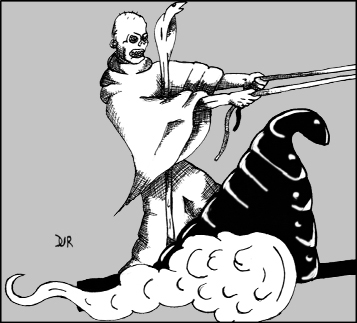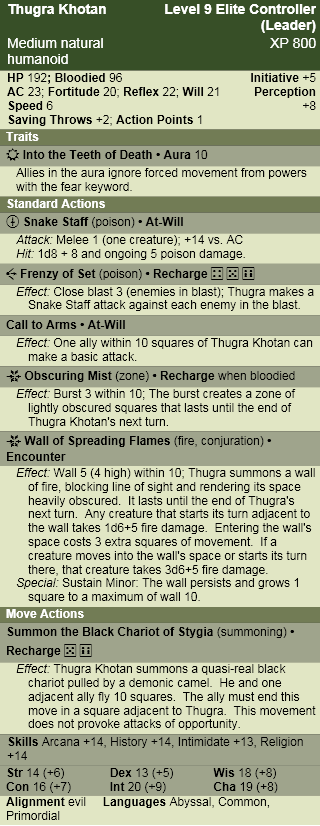Black Colossus is most well known for containing many of the ideas and plot points that Howard later re-used for his Conan novel The Hour of the Dragon, but is, I think, an excellent story on its own. In particular, I love the introduction. It perfectly captures the feeling and tone of something that would later become integral to D&D: exploring dangerous, ancient ruins and disarming deadly traps.
Spoiler Alert! All of these Hyborian age posts are going to be filled with spoilers. From the summary, to the monster stats they are going to ruin any surprises as to what the monster is, when they pop up in the story and how and why they are killed. You’ve been warned.
Summary
In the three-thousand year old ruins of Kuthchemes, a Zamoran master thief breaks the seal on a strangely preserved ivory dome and releases the wizard Thugra Khotan from his long slumber. Thugra assumes the identity of ‘Natohk the veiled one’ (how very Alucard of him) and raises a horde of desert nomads and elite Kushite warriors. Hungry for conquest and revenge against the Hyborian peoples that overran his kingdom so long ago, Natohk heads north, towards the kingdom of Khoraja.
Before his army reaches its first target, Natohk torments Khoraja’s ruler, the princess Yasmela, with his dark magic. Desperate, Yasmela goes to the temple of Mitra for guidance. Here, the voice of the god tells the princess that her and her people’s only hope is for her to go into the street and place her kingdom in the hands of the first man she meets there.
As fate would have it, she runs into the mercenary Conan whom s he gives control of the military. The nobles of Khoraja chafe at the idea of being led by a barbarian, but there is little choice, so the army rides out to meet Natohk’s nomads before the city is sieged.
he gives control of the military. The nobles of Khoraja chafe at the idea of being led by a barbarian, but there is little choice, so the army rides out to meet Natohk’s nomads before the city is sieged.
A titanic battle ensues, one where Conan has to face not only Natohk’s sorcery (he uses summoned mists to conceal troop movements and creates magical walls of flame), but also the arrogance and insubordination of Khoraja’s elite.
In the end, Conan’s superior tactics win the battle, but Natohk abducts Yasmela and speeds away on his demon drawn chariot with the Cimmerian in hot pursuit. The sorcerer blames the loss on his lust for the princess and intends to sacrifice her to restore his powers. Fortunately Conan arrives before he is able, hurling his sword and impaling Natohk before he can work any magic (and thus inspiring countless movies and comics where swords have been used as projectiles since).
Thugra Khotan
“Natohk faced the Cimmerian – inhumanly tall and lean, clad in shimmering green silk. He tossed back his veil, and Conan looked into the features he had seen depicted on the Zugite coin… Thugra Khotan’s skull-like countenance split in a mummy-like grin.” – Robert E. Howard, Black Colossus.
Lore
Nature DC 15: Thugra Khotan is an ancient Stygian sorcerer who put himself in a deep magical slumber when the city he ruled was overrun by invading barbarians. If he were to awaken, he would surely work to restore his lost glory and take revenge against the nations descended from his enemies.
Thugra Khotan in Combat
Thugra sees himself as a great general and leader of men. He enjoys using his magical abilities to control the battlefield and execute complex strategies and ambushes. His followers obey his orders without question, for they know that Thugra’s displeasure is far worse than anything their enemies can inflict.
The Stygian has no compunctions about withdrawing from a losing battle. After all, armies can be raised, servitors can be summoned, and if need be the sorcerer can seal himself away again and wait for his foes to turn to dust.
Encounters
Thugra Khotan is a master of ritual magic, especially the summoning and binding of demons, and is always accompanied by a barlgura bodyguard. In the years since his city’s downfall, the legend of his power spawned a small but dedicated cult who is now instrumental in recruiting for the sorcerer’s army. The ranks of this horde swell with a motley assortment of bandits, mercenaries, and thugs, lured by the promise of gold, glory and bloodshed.
Most of Thugra Khotan’s targets are well acquainted with the ancient sorcerer long before his minions storm a wall or batter a gate. The Stygian is a master of psychological warfare and takes great pleasure in tormenting his adversaries with sending and other magical forms of intimidation.
Notes
I admit I chose to make Thugra level 9 purely so that he could be teamed up with a barlgura lackey – just like he was in the story (well it wasn’t exactly a barlgura, it was an ape-demon, but I think the barlgura is close enough).
I wasn’t sure if I should make him undead or not since he’s described as looking like a mummy, but I don’t think he was (he was held in stasis in the ivory dome, he had mortal lusts and he was killed by a sword through the chest… I also wanted to differentiate him from a normal D&D lich). If an undead Thugra fits your game better it’s easy enough to change and doesn’t really impact anything.
Finally, the lore check uses the Nature skill simply because that’s the 4e convention for creatures with the natural origin. I think it’s much more appropriate to use the History skill instead (that’s happened before – more and more it looks to me like the knowledge skills and monster origins aren’t lining up as smoothly as I would like in 4e).
Tags: 4e, Conan, D&D, Original Art
Pingback: The Slithering Shadow « Ménage à Monster